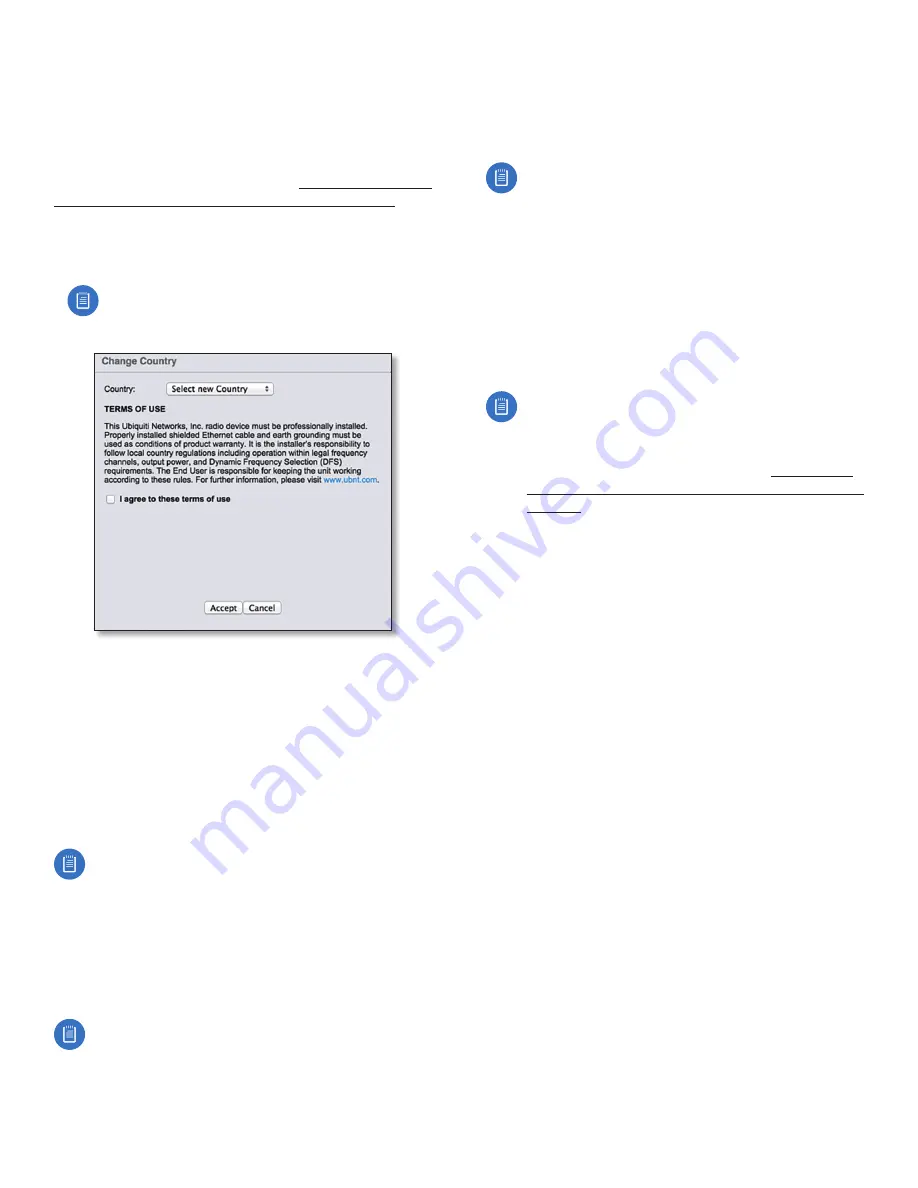
18
Chapter 5: Wireless Tab
airFiber
®
X User Guide
Ubiquiti Networks, Inc.
Country Code
Each country has its own power level
and frequency regulations.
To ensure the airFiber X radio
operates under the necessary regulatory compliance rules,
you must select the country where your device will be used
.
The frequency settings and output power limits will
be tuned according to the regulations of the selected
country. For details, refer to this table,
and Power Levels per Country/Region” on page 49
.
This radio is restricted to use with a license and to use only in
certain EU countries or geographical areas of EU countries.
•
Change
To select a new country, click
Change
.
Note:
U.S. product versions are locked to the U.S.
Country Code to ensure compliance with FCC
regulations.
-
Country
Select the new country.
-
I agree to these terms of use
Check this box; you
must agree to the
Terms of Use
to use the product.
-
Accept
Saves your change.
-
Cancel
Discards your change.
Channel Bandwidth
Select the appropriate channel size:
• AF-2X and AF-3X:
3.5
,
5
,
7
,
10
,
14
,
20
,
28
,
30
,
40
,
50
,
or
56
MHz
• AF-5X only:
5
,
10
,
20
,
30
,
40
, or
50
MHz
Note:
. The available channel bandwidths depend
on the regulatory requirements of the currently
selected country or region.
Frame Length
(Available on AF-2X and AF-3X only.) Use
this to specify the frame length of the radio:
default
,
2.0ms
,
2.5ms
,
4.0ms,
or
5ms
. The frame length must be
the same on both Master and Slave radios. The
default
value corresponds to
5ms for the 3.5 MHz and 5 MHz
bandwidths, or
2.0ms
for all other bandwidths.
Note:
. The AF-5X uses a frame length of 2.0ms (this
value cannot be changed).
Master TX Duty Cycle
Use this to change the duty cycle
of the RF link (the Master’s TX percentage). Choose one of
the following values:
25%
,
33%
,
50%
,
67%
, or
75%
.
Output Power (EIRP)
Defines the maximum average
transmit output power (in dBm) of the airFiber X radio.
To specify the output power, use the slider or manually
enter the output power value. The transmit power level
maximum is limited according to country regulations.
Note:
The
Antenna Gain
and
Cable Loss
should be
configured before the
Output Power
. This is because
the range of the
Output Power
field is affected by
the
Antenna Gain
and
Cable Loss
values – changing
the antenna gain or cable loss adjusts the maximum
and minimum values you can select using the
Output Power
slider. Since the
Output Power
already includes the antenna gain and cable loss, it
represents EIRP; therefore, the value of
Output Power
is actually the total power the radio is transmitting
over the air. The current transmit power is displayed
by the TX Power EIRP setting on the
Main
tab.
Note:
The airFiber X radio may limit the output
power to a value less than the value specified
by this field, to comply with regulatory region
requirements. For a list of maximum output power
values by country and region, refer to
Ranges and Power Levels per Country/Region” on
page 49
.
Antenna Gain
Enter the gain in dBi of the antenna that is
used in your installation. An improper value could cause
DFS false detections when operating on DFS frequencies.
Cable Loss
Enter the cable loss in dB of the cable that is
used in your installation. An improper value could cause
DFS false detections when operating on DFS frequencies.
Maximum Modulation Rate or Modulation Rate
Higher
modulations support greater throughput but generally
require stronger RF signals and a higher Signal-to-Noise
Ratio (SNR). By default,
Automatic Rate Adaptation
is
enabled, and
Maximum Modulation Rate
is displayed. This
allows the airFiber X radio to automatically adjust the
modulation rate to changing RF signal conditions. Under
certain conditions, you may prefer to lock the
Maximum
Modulation Rate
to a lower setting to improve link
performance.
When
Automatic Rate Adaptation
is disabled,
Modulation
Rate
is displayed. Lock the
Modulation Rate
to the setting
of your choice.
Select one of the available modulation rates:
•
8x (256QAM MIMO)
•
6x (64QAM MIMO)
•
4x (16QAM MIMO)
•
2x (QPSK MIMO)
•
1x (½ Rate QPSK xRT)
•
¼x (¼ Rate QPSK xRT)






























